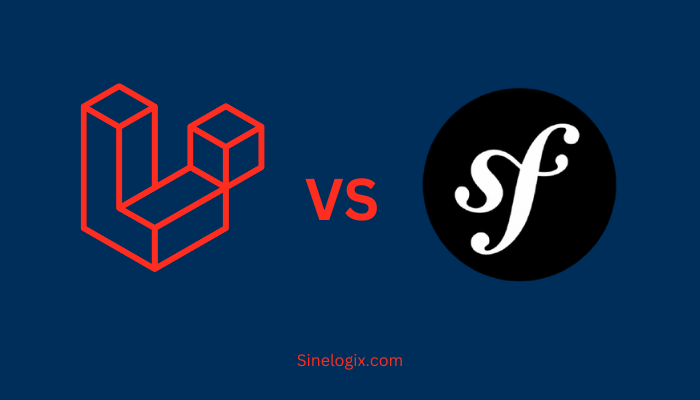Choosing the right PHP framework is a pivotal decision for developers embarking on web development projects. Laravel and Symfony consistently emerge as frontrunners in this domain, each with its unique set of features, advantages, and use cases.
In this in-depth article, we will delve into the nuances of Laravel and Symfony, aiming to provide a comprehensive understanding of these frameworks to assist developers in making informed decisions.
Features
Both Laravel and Symfony share fundamental features common to modern PHP frameworks, such as Model-View-Controller (MVC) architecture, Object-Relational Mapping (ORM), and built-in support for unit testing. However, their approaches to these features differ significantly.
Laravel, renowned for its elegant and expressive syntax, prides itself on providing a smooth and beginner-friendly experience. Laravel’s feature set includes an expressive ORM called Eloquent, a powerful template engine called Blade, and a convenient query builder. The framework promotes the principle of “convention over configuration,” reducing the need for developers to make unnecessary decisions.
Symfony, on the other hand, adopts a more modular approach with reusable components. This modularity offers a high degree of flexibility and customization options for developers. Symfony’s components can be used independently in other projects, showcasing its commitment to the principles of Don’t Repeat Yourself (DRY) and reusability. Doctrine, Symfony’s ORM, provides a robust and extensible solution for database interaction.
Market Usage Statistics
Understanding the market adoption of Laravel and Symfony is crucial for developers looking to align their skills with industry demands. As of the latest data, Laravel has gained significant popularity, particularly in the mid-sized project and startup space. Its simplicity and ease of use have contributed to a vibrant community and a plethora of packages available through Composer.
Symfony, on the other hand, has found a strong foothold in enterprise-level projects. Known for its scalability and robust architecture, Symfony is the framework of choice for developers tackling complex and large-scale applications. The Symfony community, while not as large as Laravel’s, is active and dedicated to maintaining the framework’s standards.
Popularity Over the Years
Examining the historical popularity of Laravel and Symfony provides insights into their evolution and sustained relevance. Laravel has witnessed a meteoric rise in popularity since its introduction. The framework’s commitment to modern development practices, coupled with its focus on developer experience, has contributed to its widespread adoption.
Symfony, while not experiencing the same explosive growth, has maintained a steady presence in the PHP framework landscape. Its emphasis on stability, backward compatibility, and long-term support appeals to enterprises and projects with extended development cycles.
Pros and Cons of Laravel and Symfony
To make an informed decision, developers must consider the strengths and weaknesses of each framework.
Laravel’s Pros:
- Elegant syntax and developer-friendly features.
- Active and large community, leading to extensive documentation and tutorials.
- Rich ecosystem of packages available through Composer.
- Rapid application development (RAD) features, making it ideal for startups and smaller teams.
Laravel’s Cons:
- May not be as suitable for large, enterprise-level projects with complex requirements.
- Convention over configuration can limit flexibility in certain scenarios.
Symfony’s Pros:
- Modular and flexible architecture, allowing for customization and scalability.
- Robust components, facilitating the development of large-scale applications.
- Excellent support for enterprise-level projects and complex business logic.
Symfony’s Cons:
- Steeper learning curve, especially for beginners.
- Larger projects may require more boilerplate code compared to Laravel.
Applications
Laravel and Symfony find applications across a broad spectrum of web development projects, but their suitability varies based on project requirements.
Laravel Applications:
- Content management systems (CMS).
- E-commerce platforms.
- Small to medium-sized web applications.
- Prototyping and rapid development.
Symfony Applications:
- Enterprise-level applications.
- Customer Relationship Management (CRM) systems.
- Complex web solutions with intricate business logic.
- Large-scale projects with high customization requirements.
Laravel Vs Symfony: A Detailed Comparison
Similarities and Differences
While Laravel and Symfony both originate from the Symfony components, they differ in their design philosophies and approaches.
Similarities:
- Both frameworks follow the MVC architecture.
- Use Composer for package management.
- Have robust communities contributing to their ecosystems.
Differences:
- Laravel prioritizes simplicity and ease of use, emphasizing convention over configuration.
- Symfony adopts a more modular approach, offering greater flexibility and customization options.
- Laravel’s expressive syntax appeals to developers seeking a streamlined experience.
- Symfony’s configuration-centric approach provides more control over the application’s behavior.
Laravel Vs Symfony: Which Should You Choose?
The ultimate decision between Laravel and Symfony depends on a thorough evaluation of your project’s needs and your team’s expertise.
Consider Laravel if:
- You prioritize ease of use and quick development.
- Your project is relatively small to medium-sized.
- You value the simplicity and elegance of Laravel’s syntax.
Consider Symfony if:
- Your project is large-scale or enterprise-level.
- Customization and scalability are critical requirements.
- You are comfortable with a steeper learning curve and value configuration control.
Alternatives of Laravel and Symfony
While Laravel and Symfony dominate the PHP framework landscape, exploring alternative frameworks may unveil a better fit for specific projects.
CodeIgniter:
- Known for its simplicity and small footprint.
- Suitable for small to medium-sized projects with straightforward requirements.
Yii:
- A high-performance framework with a strong emphasis on code generation.
- Ideal for projects requiring rapid development and scalability.
Zend Framework:
- Offers a collection of professional PHP packages.
- Suitable for large-scale projects with complex requirements.
Does Laravel Use Symfony?
Laravel and Symfony are distinct frameworks, but Laravel incorporates some Symfony components. Laravel relies on Symfony’s HTTP foundation components, enhancing its functionality and showcasing the interoperability within the PHP ecosystem.
Is Symfony Same As Laravel?
Symfony and Laravel are not the same; they are separate frameworks with unique characteristics. While Laravel draws inspiration from Symfony and uses some of its components, the frameworks differ in syntax, approach, and developer experience.
Can you migrate a project from Laravel to Symfony or vice versa?
Migrating a project from Laravel to Symfony or vice versa is a complex task. The frameworks have different architectures and conventions, making direct migration challenging. It often involves rewriting significant portions of the codebase. The decision to migrate should be based on a careful assessment of project requirements and the benefits offered by the target framework.
Related Articles:
Conclusion
In conclusion, the choice between Laravel and Symfony is a nuanced decision that requires careful consideration of various factors. Both frameworks have their strengths and weaknesses, and the right choice depends on the specific needs of your project.
Laravel excels in rapid application development and is well-suited for startups and smaller teams. Symfony, with its robust architecture, is the preferred choice for large-scale enterprise projects requiring high customization and scalability.




